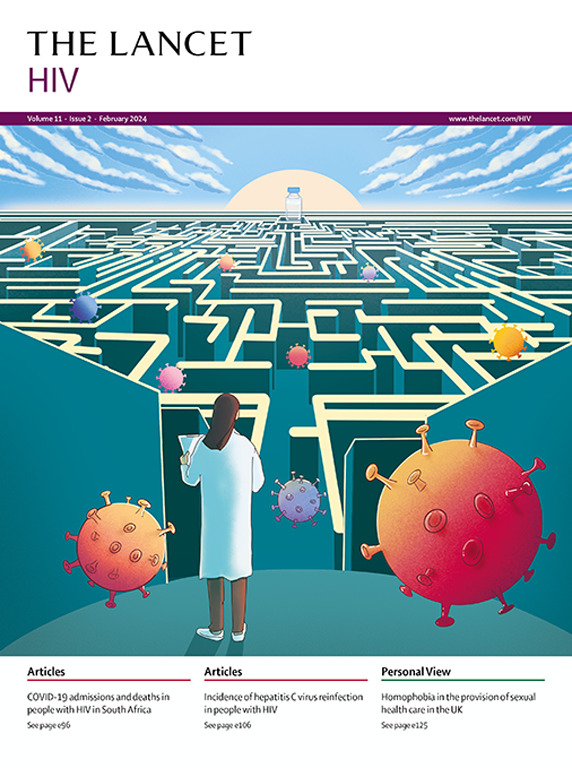Dynamic choice HIV prevention with long-acting injectable cabotegravir pre-exposure prophylaxis in east, central, southern, and west Africa: a cost-effectiveness modelling analysis.
IF 13
1区 医学
Q1 IMMUNOLOGY
引用次数: 0
Abstract
BACKGROUND In randomised controlled trials in Kenya and Uganda, a dynamic choice HIV prevention (DCP) intervention that offered structured choice of biomedical prevention product and opportunity to change products over time substantially improved prevention coverage; incident HIV infections were eliminated when long-acting cabotegravir was included as an option. We aimed to assess the potential cost-effectiveness of the intervention regimen in east, central, southern, and west Africa. METHODS We used the existing individual-based HIV Synthesis model. Through sampling of parameter values at the start of each model run of a simulated population of adults, we created 1000 setting-scenarios, reflecting uncertainty in assumptions and a range of characteristics similar to those seen in east, central, southern, and west Africa. For each setting-scenario, we simulated predicted outcomes including disability-adjusted life-years (DALYs) and costs up to 50 years resulting from (1) continuing with the status quo (ie, no DCP); (2) introduction of the DCP intervention with oral pre-exposure prophylaxis (PrEP), post-exposure prophylaxis (PEP), and condoms without long-acting cabotegravir PrEP (ie, DCP without cabotegravir); and (3) introduction of the DCP intervention and including long-acting cabotegravir PrEP (ie, DCP including cabotegravir). We used a cost-effectiveness threshold of US$500 per DALY averted, and a discount rate of 3% per year. The annual cost of DCP including cabotegravir was assumed to be $190 per person. Net DALYs averted was calculated by DALYs averted plus the difference in costs divided by the cost-effectiveness threshold. FINDINGS Reflecting the trial results, among people with a PrEP indication (ie, having an HIV acquisition risk) and an HIV test in the past 3 months, the median proportion of people on PrEP was 14% (90% range 4-43) with no DCP, 54% (23-74) with DCP without cabotegravir, and 71% (35-83) with DCP including cabotegravir. These increases in PrEP use led to HIV incidence reductions, with incidence rate ratios of 0·89 (0·67-1·17) for DCP without cabotegravir and 0·64 (0·44-0·97) for DCP including cabotegravir, relative to no DCP. Across setting-scenarios, both DCP policies led to DALYs being averted: 18 400 DALYs per year (95% CI 16 700-20 100) for DCP including cabotegravir and 56 400 DALYs per year (52 300-60 500) for DCP without cabotegravir in 10 million adults. Compared with no DCP, there was a mean increase in annual discounted costs over 50 years: $8·6 million (7·7-9·4) for DCP without cabotegravir and $13·2 million (11·6-14·8) for DCP including cabotegravir. Addition of long-acting cabotegravir PrEP to DCP was cost-effective (vs DCP without cabotegravir); the incremental cost-effectiveness ratio for DCP including cabotegravir (vs no DCP) was $234 per DALY averted. There was substantial variation across setting-scenarios and we found that DCP was more likely to be the cost-effective choice in settings with high prevalence of unsuppressed HIV or low proportion of people with an indication for PrEP. INTERPRETATION Offering structured PrEP and PEP choice including long-acting cabotegravir and enabling risk-informed use could reduce HIV incidence by a third over 10 years. If projected generic production costs of long-acting cabotegravir can be realised, it is likely to be cost-effective across multiple settings in east, central, southern, and west Africa. FUNDING US National Institutes of Health.东非、中非、南部和西非长效注射卡布特韦暴露前预防的动态选择HIV预防:成本效益模型分析
背景:在肯尼亚和乌干达的随机对照试验中,动态选择艾滋病毒预防(DCP)干预提供了生物医学预防产品的结构化选择和随时间改变产品的机会,大大提高了预防覆盖率;当长效卡布特韦作为一种选择时,HIV感染事件被消除。我们的目的是评估干预方案在东非、中非、南部和西非的潜在成本效益。方法采用现有的基于个体的HIV综合模型。通过在模拟成年人群体的每个模型运行开始时对参数值进行抽样,我们创建了1000个设定情景,反映了假设中的不确定性以及与东非、中非、南部和西非相似的一系列特征。对于每个设定情景,我们模拟了预测结果,包括残疾调整生命年(DALYs)和由于(1)继续保持现状(即没有DCP)而导致的高达50年的成本;(2)采用口服暴露前预防(PrEP)、暴露后预防(PEP)和不含长效卡伯地韦PrEP(即不含卡伯地韦的DCP)的安全套进行DCP干预;(3)引入DCP干预,包括长效cabotegravir PrEP(即DCP包括cabotegravir)。我们使用的成本效益门槛为每个避免的DALY 500美元,贴现率为每年3%。包括卡伯地韦在内的DCP的年费用假定为每人190美元。避免的DALYs净值是通过避免的DALYs加上成本差额除以成本效益阈值来计算的。研究结果反映了试验结果,在有PrEP指征(即有HIV感染风险)并在过去3个月内进行过HIV检测的人群中,不使用DCP的PrEP患者中位比例为14%(90%范围为4-43),不使用卡伯地韦的DCP患者中位比例为54%(23-74),使用含卡伯地韦的DCP患者中位比例为71%(35-83)。PrEP使用的增加导致HIV发病率下降,与不使用DCP相比,不使用cabotegravir的DCP的发病率比为0.89(0.67 - 1.17),而使用cabotegravir的DCP的发病率比为0.64(0.44 - 0.97)。在设定情景中,两种DCP政策都避免了DALYs:在1000万成年人中,包括卡伯地韦的DCP每年18 400 DALYs (95% CI 16 700-20 100),不含卡伯地韦的DCP每年56 400 DALYs(52 300-60 500)。与不使用cabotegravir相比,50年的年折现成本平均增加:不使用cabotegravir的DCP增加860万美元(7.7 - 9.4),使用cabotegravir的DCP增加1320万美元(11.6 - 14.8)。在DCP中添加长效cabotegravir PrEP具有成本效益(与不添加cabotegravir的DCP相比);包括卡伯地韦在内的DCP(与无DCP相比)的增量成本-效果比为每避免DALY 234美元。在不同的环境情景中存在很大的差异,我们发现DCP在未抑制的艾滋病毒感染率高或有PrEP适应症的人群比例低的环境中更有可能是具有成本效益的选择。解释提供有组织的PrEP和PEP选择,包括长效卡博特韦和允许风险知情使用,可以在10年内将艾滋病毒发病率降低三分之一。如果长效卡布特韦的预期仿制药生产成本能够实现,那么在东非、中非、南部和西非的多个环境中,它可能具有成本效益。美国国立卫生研究院。
本文章由计算机程序翻译,如有差异,请以英文原文为准。
求助全文
约1分钟内获得全文
求助全文
来源期刊

Lancet Hiv
IMMUNOLOGYINFECTIOUS DISEASES&-INFECTIOUS DISEASES
CiteScore
19.90
自引率
4.30%
发文量
368
期刊介绍:
The Lancet HIV is an internationally trusted source of clinical, public health, and global health knowledge with an Impact Factor of 16.1. It is dedicated to publishing original research, evidence-based reviews, and insightful features that advocate for change in or illuminates HIV clinical practice. The journal aims to provide a holistic view of the pandemic, covering clinical, epidemiological, and operational disciplines. It publishes content on innovative treatments and the biological research behind them, novel methods of service delivery, and new approaches to confronting HIV/AIDS worldwide. The Lancet HIV publishes various types of content including articles, reviews, comments, correspondences, and viewpoints. It also publishes series that aim to shape and drive positive change in clinical practice and health policy in areas of need in HIV. The journal is indexed by several abstracting and indexing services, including Crossref, Embase, Essential Science Indicators, MEDLINE, PubMed, SCIE and Scopus.
 求助内容:
求助内容: 应助结果提醒方式:
应助结果提醒方式:


